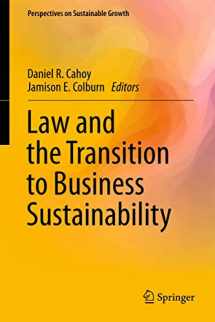
Law and the Transition to Business Sustainability (Perspectives on Sustainable Growth)
ISBN-13:
9783319047225
ISBN-10:
3319047221
Edition:
2014
Author:
Daniel R. Cahoy, Jamison E. Colburn
Publication date:
2014
Publisher:
Springer
Format:
Hardcover
164 pages
FREE US shipping
Book details
ISBN-13:
9783319047225
ISBN-10:
3319047221
Edition:
2014
Author:
Daniel R. Cahoy, Jamison E. Colburn
Publication date:
2014
Publisher:
Springer
Format:
Hardcover
164 pages
Summary
Law and the Transition to Business Sustainability (Perspectives on Sustainable Growth) (ISBN-13: 9783319047225 and ISBN-10: 3319047221), written by authors
Daniel R. Cahoy, Jamison E. Colburn, was published by Springer in 2014.
With an overall rating of 3.9 stars, it's a notable title among other
Environmental Economics
(Economics, Economics, International Business, Commercial, Business Law, Environmental & Natural Resources Law, Law Specialties) books. You can easily purchase or rent Law and the Transition to Business Sustainability (Perspectives on Sustainable Growth) (Hardcover) from BooksRun,
along with many other new and used
Environmental Economics
books
and textbooks.
And, if you're looking to sell your copy, our current buyback offer is $0.3.
Description
This book expands on law-related research by examining the legal aspects of sustainability with a focus on the impact on business strategies. It recognizes that firms must adopt an integrated approach to law and sustainability, considering multiple disciplines and goals, and serve as a forum for bringing together scholarship from fields such as environmental law, energy, government regulation and intellectual property. Firms increasingly have an interest in transitioning to sustainable business practices that take into consideration the fact that global resources are finite and will be increasingly scarce. They acknowledge that current actions have social, economic and environmental consequences and employ options to ensure that future generations have the same options and benefits. Examples of sustainable practices increasingly employed by firms include the institutionalization of “whole life-cycle” analysis in marketing and product design, utilization of sustainable inputs and energy sources, tracking and reporting sustainability performance, attempting the valuation of future generation prosperity and happiness as a discounting mechanism, and integrating sustainability into firm culture and management goals. It is clear that law and regulation have an extremely important role to play in the transition to more sustainable business practices. Broadly stated, law can provide structure for firms responding to forces that pull transition by enabling sustainability leadership and competitive advantage through funding models, intellectual property rights and collaboration means. Additionally, law can work to push transition by compelling firms to act through regulatory structures, accounting and governance mechanisms.


We would LOVE it if you could help us and other readers by reviewing the book
Book review

Congratulations! We have received your book review.
{user}
{createdAt}
by {truncated_author}


